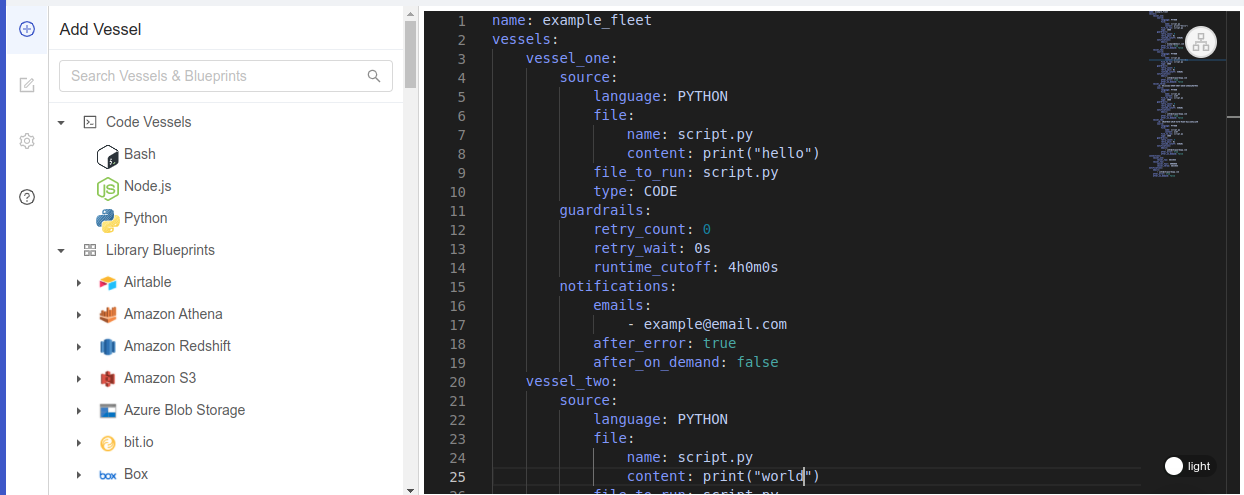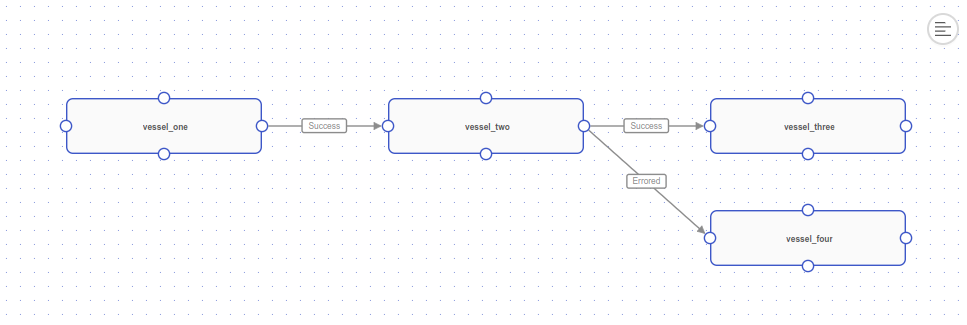YAML Editor
Definition
In addition to the Visual editor, the Fleet Builder also has a YAML editor to directly edit the Fleet configuration. This system allows for users to take a more code-based approach to constructing their workflow definitions. Additionally, it makes it easier for users to share their configured workflows with teammates and other developers.
In order to access the YAML editor, ensure that your Fleet is saved.
- Click "Save" if the option is available
- Click the text icon in the top right corner of the Visual editor
- Edit code in-line
- Click "Save" to save your changes

YAML Specification
Below are the top-level fields that make up a FAC YAML file. Sub-objects are defined beneath these as needed.
name
name is the string name of the Fleet. It is a required field.
If both a name and _id field are provided at the top-level of the file, Platform will attempt to update a Fleet with that _id value with the name field.
_id
_id is an optional top-level value representing the ID of an existing Fleet. If provivded, Platform will attempt to look it up and apply the FAC YAML as an update to the Fleet.
If the ID value does not exist, Platform will attempt to create a new Fleet with the information provided.
vessels
vessels represents the Vessels that constitute the Fleet. Keys represent the name of the Vessel and must be unique within the Fleet object. Values are the Vessel definition represented as a YAML object which may be code-based, Blueprint-based, or Git-based.
Vessels may have a _id top-level field.
long_vessel_name:
_id: example_uuid
If _id is provided, Platform will attempt to find and update the Vessel with the provided values.
Below are examples of the three types with accompanying notes on the various fields that go under the source field.
- Code
- Blueprint
- Git
source:
type: CODE
language: PYTHON
version: "3.9"
file:
name: script.py
content: |
for i in range(10):
print(i)
file_to_run: script.py
languagemay be one ofPYTHON,BASH, orNODEnameis a string represented the file name containing the codecontentis a string or multiline string containing the codefile_to_runindicates the file to run that contains the Vessel code - for aCODEVessel type, this is likely the same asnameabove
source:
type: BLUEPRINT
blueprint: "Email - Send Message"
inputs:
EMAIL_SENDER_ADDRESS: example@email.com
...
blueprintis the name of the Blueprint created separately from the Fleet - it must match the name exactly and may either be a Library Blueprint or an Organization Blueprintinputsare a key-value pair representing the input variable name and value- the "key" maps to the Reference Name for any Blueprint Input
- if the Blueprint is configured so that the input is a "password" type, when this FAC is fetched back to the user it will show
SHIPYARD_HIDDENto obfuscate the value
source:
type: CODE
language: PYTHON
version: "3.9"
git:
repository: owner/repo
checkout_point: master
clone_location: REPO_NAME
file_to_run: script.py
repositoryis a string representing the GitHub repository owner and namecheckout_pointis a string representing the branch or tag to checkoutclone_locationindicates where to download the repo to and may either beREPO_NAMEorCWDfile_to_runis a string representing the file to for any Vessel type that requires it- see Git connections for more information
In addition to these code source-specific objects, there the standard requirements configurations common to all Vessels are also available within the source field. These are all optional. Any combination of these fields may be provided.
arguments
source:
...
arguments:
- key: example_key_1
value: example_value_1
- { key: example_key_2, value: example_value_2 }
environment
source:
...
environment:
- name: variable_name_1
value: variable_value_1
- { name: variable_name_2, value: variable_value_2 }
See Environment Variables for more information
packages
source:
...
packages:
- name: example_package
version: '==1.0.0'
versionis an optional string value
See Packages for more information.
system_packages
source:
...
system_packages:
- name: example_package
These are the same structure as packages above and are available for PYTHON and NODE Vessel types only. See System Packages for more information
Additionally, there are optional Guardrail and Notification settings available for Vessel objects. These both live at the same level as the source field. See below for examples.
guardrails
vessel_name:
...
guardrails:
retry_count: 3
retry_wait: 5m0s
runtime_cutoff: 15m0s
exclude_exit_code_ranges:
- 2
- '3-5'
retry_countis an integer representing the number of times to retry a Vessel if it fails (max of 24)retry_waitis a string representing the amount of time to wait between retries (max of 1h) - the example above indicates a retry wait of 5 minutesruntime_cutoffis a string representing the amount of time to wait before killing a Vessel (max of 4h) - the example above indicates a runtime cutoff of 15 minutesexclude_exit_code_rangesis an array of values (integers or strings formated at "N-N") representing the exit codes to exclude from the Vessel's exit code range - the example above indicates that exit codes2,3,4, and5should be excluded
Formatting for retry_wait and runtime_cutoff follow a "#h#m#s" format for hours, minutes, and seconds. These values must be divisible by 5 minute increments.
notifications
vessel_name:
...
notifications:
emails:
- example@email.com
- another@email.com
after_error: true
after_on_demand: false
emailsis an array of email addresses to send notifications toafter_erroris a boolean indicating whether to send a notification after a Vessel after a Vessel completes with a status of Erroredafter_on_demandis a boolean indicating whether to send a notification after a Vessel is run on demand
connections
connections is a top-level field that defines how the Vessels, defined in the vessels section, are connected together.
Each key in the object is a Vessel name value (if provided) representing the "from" Vessel and the value is an object that contains the "to" Vessel(s) and the connection type. See below for an example.
connections:
vessel_one:
vessel_two: SUCCESS
vessel_two:
vessel_three: SUCCESS
vessel_four: ERRORED
This example indicates that if vessel_one succeeds, it will invoke vessel_two and if vessel_two succeeds, it will invoke vessel_three. If vessel_two fails, it will invoke vessel_four.
Below is what the YAML configuration above would look like in the Visual editor.

See Fleets documentation for more information on connections.
triggers
Currently, the triggers supported in FAC are Schedules. These are defined as an array of objects under the schedules field. See below for an example.
triggers:
schedules:
- how_often: HOURLY
at: ':00'
- how_often: DAILY
at: '2:00'
- how_often: WEEKLY
at: '3:00'
when: WEDNESDAY
- how_often: MONTHLY
at: '22:00'
when: 1
In these examples there are four schedules set on the Fleet. Note that the times are represented in 24-hour format.
- running hourly on the hour
- running daily at 2:00 AM
- running weekly on Wednesday at 3:00 AM
- running monthly on the 1st at 10:00 PM
notifications
This is the same object available under the Vessels notifications field. If configured, this will emit notifications based on actions of the full Fleet.
notifications:
emails:
- example@email.com
- another@email.com
after_error: true
after_on_demand: false
Examples and Templates
Below is a full example FAC file.
Right now, comments will not be saved or rendered whenever the Fleet is saved and refreshed. This is because the YAML is generated based on the inputs available in the Visual Editor rather than stored in a file. This will be addressed in a future release.
name: Example Fleet
vessels:
FirstVessel:
source: # source holds all Vessel-code related resources
type: CODE # (required) "CODE" or "BLUEPRINT" values allowed
language: PYTHON # (required) "PYTHON", "NODE", or "BASH" values allowed
# name and content define the file holding "CODE" Vessel code to execute
# multiline strings are supported using the YAML "|" syntax
version: "3.9" # (optional) "3.7" or "3.9" allowed.
# If not included, will use the latest version of the language.
file:
name: script.py
content: |
import os
import argparse
parser = argparse.ArgumentParser()
parser.add_argument('--example_arg')
print('hello, world!')
print(parser.parse_args())
print(os.environ['example_name_a'])
file_to_run: script.py # this generally maps to the name field above
# arguments are fed in as command line arguments to the script
# see the two formatting methods for the array below
arguments:
- '--example_arg': example_value
- { name: example_arg, value: example_value }
# environment represents environment variables made available to the script
# see the two formatting methods for the array below
environment:
- name: example_name_a
value: example_value_a
- { name: example_name_b, value: example_value_b }
guardrails:
retry_count: 1 # (optional) max of 24
retry_wait: 5m # (optional) max of 1h and must be divisible by 5 minutes
runtime_cutoff: 10m # (optional) max of 4h and must be divisible by 5 minutes
exclude_exit_code_ranges:
- 2
- '3-5'
SecondVessel:
source:
type: BLUEPRINT
blueprint: 'Example Blueprint'
inputs:
FIRST_INPUT: 'blueprint input value'
## Paste this code under 'vessels' and then connect it to other vessels under 'connections'
'ambitious_sail':
source:
type: BLUEPRINT
blueprint: 'Email - Send Message'
inputs:
'EMAIL_SEND_METHOD': 'tls' # (required) determines how email is sent - TLS is recommended
'EMAIL_SMTP_HOST': # (required) server where your email will be sent from - usually formatted "smtp.domain.com"
'EMAIL_SMTP_PORT': # (required) port to send from - 587 is recommended with TLS
'EMAIL_USERNAME': # (required) username of the address to send from
'EMAIL_PASSWORD': 'hlgyecgskabctidf' # (required) password for the "sender address"
'EMAIL_SENDER_ADDRESS': # (required) email address to send from
'EMAIL_SENDER_NAME': # (optional) name of the sender which defaults to the "sender email" if left blank
'EMAIL_TO': # (optional) emails to send to - formatted as a comma-separated list e.g. first@email.com,second@email.com
'EMAIL_CC': # (optional) emails to CC - formatted as a comma-separated list e.g. third@email.com,fourth@email.com
'EMAIL_BCC': # (optional) emails to CC - formatted as a comma-separated list e.g. fifth@email.com,sixth@email.com
'EMAIL_SUBJECT': # (optional) subject of the email
'EMAIL_MESSAGE': # (required) body of the email
'EMAIL_INCLUDE_SHIPYARD_FOOTER': true # (required) determines whether to send emails with links back to the originating Vessel or Fleet
connections:
FirstVessel:
SecondVessel: SUCCESS # (required) valid options are "SUCCESS", "ERRORED", or "COMPLETED"
triggers:
schedules:
- how_often: HOURLY
at: ':25'
notifications:
emails:
# - example@email.com (remove when using this example)
# - (add your email here)
after_error: true
after_on_demand: false